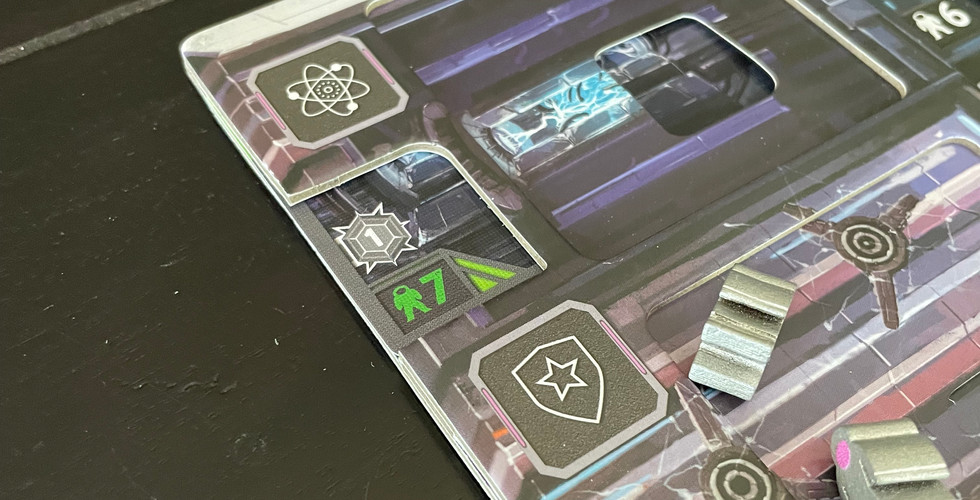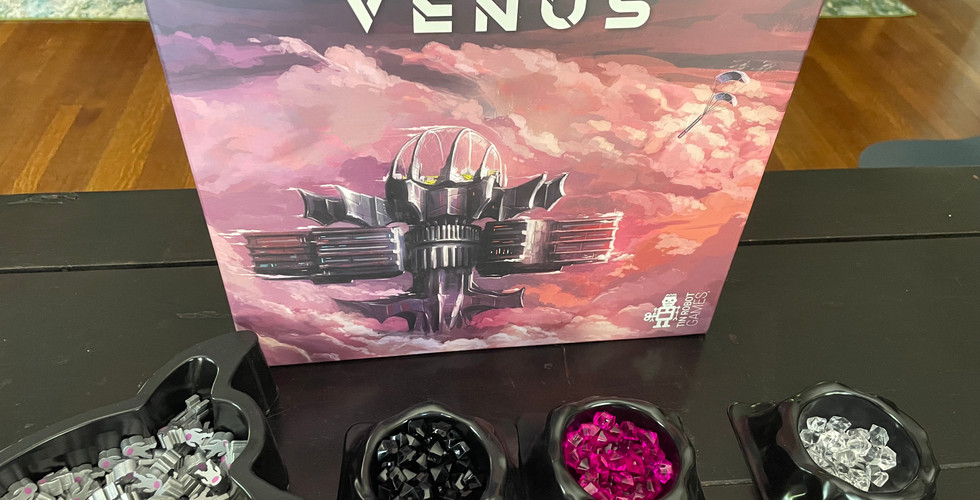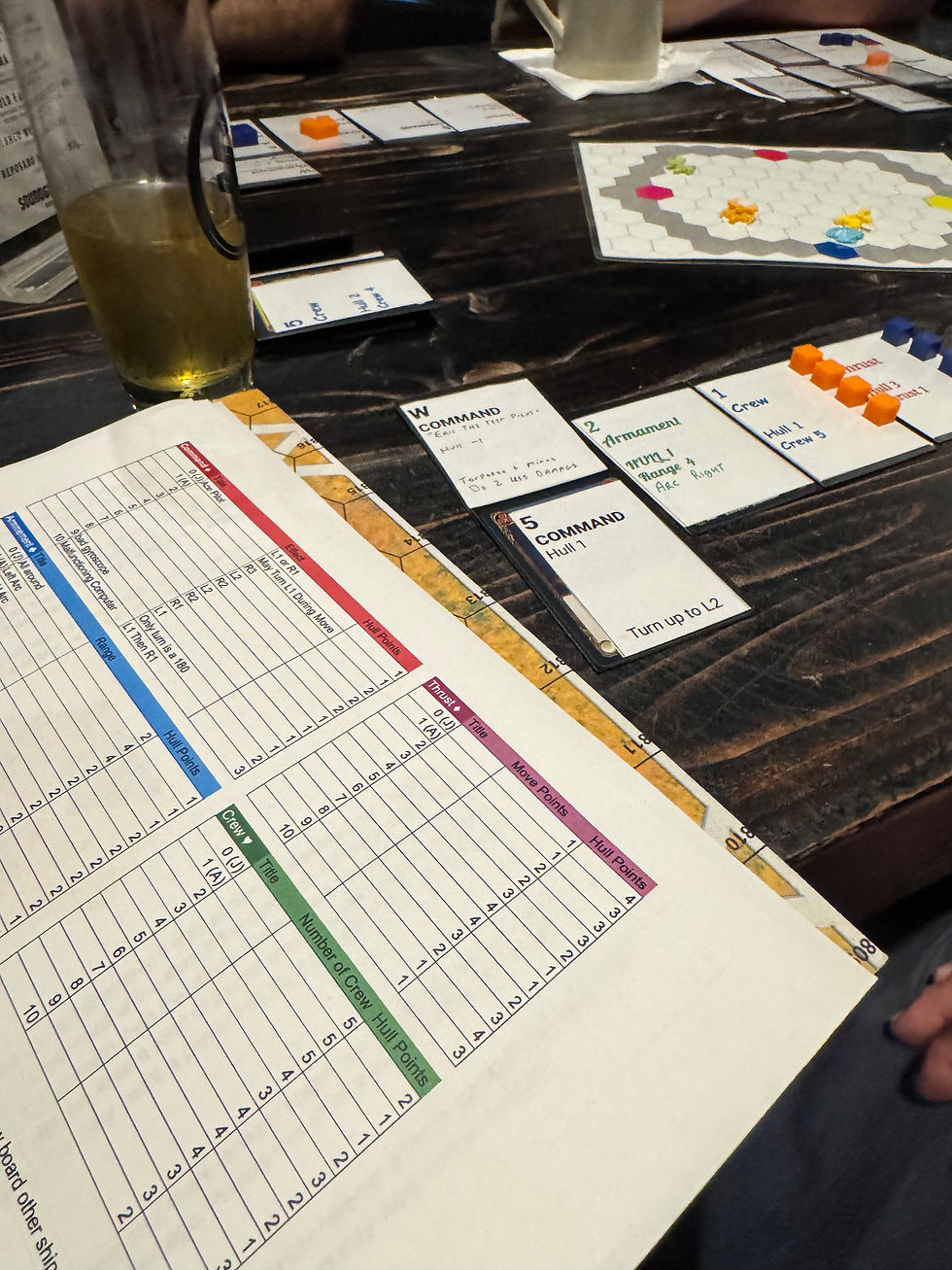Preview: Cities of Venus
- Bert

- May 17, 2023
- 5 min read
Updated: Jun 1, 2023
The year is 2222 and the governors of of the floating cities of Venus are fighting for resources as the catastrophe on Earth has the cloud drops in doubt. When will the supplies stop? How will you the governor of a cloud city be able to provide for the city and survive? Cities of Venus is a mid weight euro style game that is being published by Tin Robot Games and is designed by James Staley and Adam Staley.

Each player in Cities of Venus is running a city. They must manage the workers (V-nauts) on each of the player boards. The player with the most victory points wins at the end of the game. Players with gain victory points from Cloud Drops, City Upgrades, the player with the highest amount of V-nauts, the player with the highest amount of minerals and then players get victory points for amounts minerals and V-nauts. Do not fret, running a city in Cities of Venus pretty is not complicated as it would seem.

Cities of Venus is broken down into 6 steps for each turn. Each of the steps go by fairly quickly and makes the game move along at a great clip. Step one is setting up the Cloud Drop. The first player lays out cloud drop cards equal to the number of players plus one. Jumping a head to step 6 to give context, players will be gaining the canisters by paying the cost in V-nauts and or minerals. Back to step 2 of the game players will resolve the events (Yellow Triangles) that come up on the Cloud Drop cards. The events are drawn from the event deck and they will affect mostly your V-naut population (mostly removing them life on Venus is hard). After players have resolved the events then its time for Step 3 Lower Shields. Lowering shields means losing one V-naut from the shield section of the player board (We told you it was hard on Venus). One thing to note if a player cannot pay the one V-naut from shields then the player must remove 2 V-nauts from other places on the player board.
Each of the steps go by fairly quickly and makes the game move along at a great clip.
Now is a great time to interject with a bit of what the player board looks like. The player boards are multilevel cardboard. This gives players a nice place to put everything securely. Each of the sections has an limit to the amount of V-nauts that can be there. All spaces at a max of 6 V-nauts. The really interesting part of the player boards are the ship upgrades that slide in to each of the sections, Food, Air/Water, Power, Mechanical, Mining, Shields and the holding bay. When a player slides cards into the player board there are cut outs that reveal the advantage gained and the change the max amount (up or down) of V-nauts that can be there. There is also a side car for the player board that has all the steps and scoring but also serves as the International Innovation Station (IIS).
The really interesting part of the player boards are the ship upgrades that slide in to each of the sections
We left off at Step 4 This is the step where players add more V-nauts to the player boards. Players look at both the Food and the Air/Water spaces and whichever one has the lowest number of V-nauts between the two, that's how many new V-nauts players may add to the player board. So if a player has 4 in Food and 5 in Air/Water then 4 new V-nauts are added anywhere on the player board. This is why we spoke about step 6 a bit early, where a player places the V-nauts now can determine what they are able to afford from the cloud drop. We mentioned the IIS earlier this is a card to the side of the player board and also a place where players can place up to two V-nauts a turn. When a player has 8 on the IIS then they can return the 8 V-naughts to supply and pick up a City Upgrade.

Step 5 has players taking city actions. So if a player picked up a Cloud Drop card in an earlier turn but could not afford the cost to equip it they may pay the cost and place it now. The holding bay can hold one Cloud Drop card that has not been paid to equip. Another city action is to get more V-nauts in this step you can pay 4 mineral s for one V-naut. How does one get minerals? Well we are glad you asked. Mining, is a city action players can take where they exchange one V-naut from the Mining section ( life on Venus, man...) and roll a 6 sided die and gain that amount of minerals. This all brings us back to Step 6 where each player can take a Cloud Drop cards (in turn order) and either pay the cost and equip it or put it in the holding bay (only one card can be here at a time). The cloud drop cards will either add more V-nauts or enhance the players city.
When does this game end? Well it wont take lone for you to get to the end. The compact rules and streamlined play help usher everything along at a quick pace. The game has 3 sets of cards (Phases 1-3) that combine to make the Cloud Drop Deck. The phases are shuffled separately and not all the cards are used (this helps the repeatability). An Earth card is added into Phase 3 and then phase 2 cards are placed on top and Phase one cards on top of that. So to answer the question, the game ends at the end of the turn when the earth card is revealed.

Tin Robot Games did a great job with Cities of Venus. The Game has depth and plays quick. The teach on the game comes easy and the rules make it flow well. There is a Solo variant (that we did not get to play-test) and a score-keeping app coming as part of the Kickstarter campaign. This light to mid weight euro style game would be a great fit for a weekday for game night or as part of a bigger day of games. The Kickstarter is running until the end of the month (May 2023) so go check out all the cool stretch goals and add ons.
Players: 2-6
Year Published: 2023
Recommended Ages: 8+
Time to Play: 45-90 minutes
A review copy of Cities of Venus was provided to Bert's Tabletop Games for review purposes by Tin Robot Games. This is a pre-production copy and the final version may vary from what is depicted here.
























































Comments